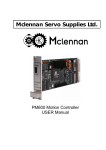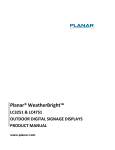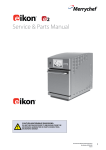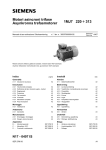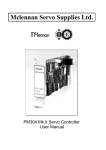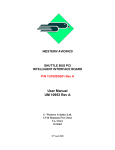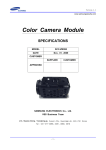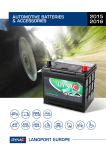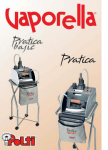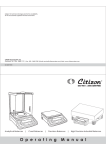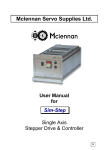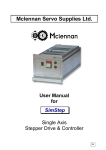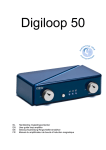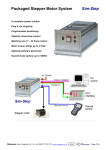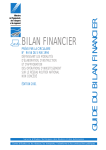Download PM600-Provisional-Manual-V3.25
Transcript
Mclennan Servo Supplies Ltd. PM600 Motion Controller Installation & USER Manual PROVISIONAL PRODUCT MANUAL FOR PM600 Digiloop ® SAFETY NOTICE ! Position control systems are inherently hazardous. Even a small motor, if coupled to a leadscrew, gearbox, or any other form of mechanism that provides a mechanical advantage, can generate considerable force and could cause serious injury. Incorrect operation can also lead to damage to the motor or associated machinery. It is essential that the purpose of the various safety features built into the PM600 be fully understood and used correctly. Caution STATIC SENSITIVE DEVICES This unit has static sensitive devices. Observe handling precautions: Hold card by edges only. Do not touch components or connector pins. Ship only in anti-static packaging. Mclennan Servo Supplies Ltd. 22 Doman Road, Yorktown Industrial Estate, Camberley, Surrey, GU15 3DF UK Telephone: +44 (0)1276 26146 FAX: +44 (0)1276 23452 Sales EMAIL: [email protected] Technical support EMAIL: [email protected] This manual is written for firmware version – V3.25a The manufacturer reserves the right to update the data used in this manual in line with product development without prior notice. PM600 V3.25 PROVISIONAL 19/04/00 7-1 CONTENTS PM600 V2.10 30 Sept. 1998 7-2 3. COMMANDS - HOW TO TALK TO THE PM600 COMMAND WORD SYNTAX The PM600 has a wide range of command options extending beyond the main move functions. The aim is to provide a flexible and comprehensive control device for integration of motion control into larger systems. Commands Most commands are two letters, the function of each, being described in the Programmer Reference section. Each command is preceded by the appropriate address to identify the axis for which the command is intended. Where applicable (e.g. move commands, setting of system parameters, etc.) the command should then be followed by the desired value: aXXnnn<cr> a = address XX = command nnn = value (if required) <cr> = carriage return. Command strings should be terminated with a carriage return character (ASCII 0D hex). Upper or lower case characters may be used for the command. Spaces within the command line are ignored. If no value is given, then zero is assumed. All commands except for Control C and ESCAPE are buffered. Commands are executed in consecutive order. Commands will be acted on sequentially, as they have been entered. If any command cannot be executed immediately (because it may need to wait for some condition or a previous command to finish) then the command and any that follow it will be buffered internally (up to 256 characters). The responses for each command are returned as the command is executed. NOTE: Delete, backspace and cursor movement characters are NOT detected by the controller. With some terminals or emulators these keystrokes will be translated as an escape sequence, i.e. a sequence of characters beginning with an escape character (ASCII 1B hex). The controller will detect the escape character and act on it accordingly. Please note that due to the loop nature of the RS232 communications, all characters that are sent to the controllers are echoed back to the host. Replies Response to a command, once it has been accepted, is either an OK string or an alpha-numeric string. Responses terminate in a carriage return character (0D) and a line feed character (0A) and are preceeded by the address number. An appropriate message is sent if a mistake or conflicting instruction creates an error. The first character of an error message is ! Non-volatile Memory All set-up parameters (control coefficients, acceleration, deceleration, velocities, jog speeds, creep speed, etc.), sequences and profiles will be read from the on board FLASH memory to the controllers normal RAM memory on power-up. The parameters may then be modified in the volatile RAM by the relevant commands, but these modifications will not persist after power down. Use the backup (BA, BC, BD, BP & BS) commands to write the current set-up back to the non-volatile FLASH memory, so that they will be ‘remembered’ on power up. PM600 V3.25 PROVISIONAL 19/04/00 7-3 7. PROGRAMMERS REFERENCE CONTROL C (ASCII 03) Hard Stop. Moves, sequences and profiles halted immediately. Motion stopped at the LD rate. Command buffer cleared. Sets status to Idle. Sequences and profiles retained in memory. Operates on all axes. ESCAPE (ASCII 27) Soft Stop Moves, sequences and profiles halted immediately. Motion stopped at the SD rate. Command buffer cleared. Status returns to Idle. Sequences and profiles retained in memory. Operates on all axes. PM600 V2.10 30 Sept. 1998 7-4 AB ABORT The control of the motor may be aborted by sending AB. When aborted, the servo loop is disabled and the status display will show C for command abort. A user abort may be reset with the RS command. The encoder positions are still read while aborted. Syntax <ad>AB Units N/A Range N/A to Condition Requirements None. Responses: ! COMMAND ABORT Example: 1AB AD Initial State N/A Privilege level 0 Notes: The response to a CO command will be Command Abort. It will override any other abort situation. Command has been accepted. Abort axis 1. AUTO-EXUCUTE SEQUENCE - DISABLE Switches off any auto-execute sequences that may have been set by the AE command. Note that this setting is written to the non volatile FLASH memory and is therefore retained after power down. Syntax <ad>AD Units Range to Condition Requirements Idle Responses: OK Example: 1AD AE Initial State Disabled Privilege level 5 Notes: Value stored in FLASH Command has been accepted. Disable auto execute of axis 1. AUTO-EXECUTE SEQUENCE - ENABLE Set sequence n to run on power-up of the controller (auto-execute). This may be used in stand alone systems where there is no permanent host computer or terminal. Note that this setting is written to the non volatile FLASH memory and is therefore retained after power down. Syntax <ad>AEn Units Seq. No. Range 0 Condition Requirements Idle Responses: OK ! INVALID SEQUENCE NUMBER ! SEQUENCE UNDEFINED Example: 1AE5 to 7 Initial State Disabled Privilege level 5 Notes: Value stored in FLASH Command has been accepted. Argument is out of valid range. Sequence specified has not been defined yet. Sets auto execute of axis 1 to run sequence 5 on power-up. PM600 V3.25 PROVISIONAL 19/04/00 7-5 AM SET ABORT MODE Set the conditions that cause an abort and disable the control (servo) loop. Syntax Units Range to Initial State <ad>AMabcdefgh Bits 0 1 00000000 where a - 0 – Abort Stop Input disables control loop 1 – Abort Stop Input stops all moves only b - 0 –Abort Stop Input is latched requiring RS command to reset 1 – Abort Stop Input is only momentary c - 0 – Stall Error disables control loop 1 – Stall Error is indicated but control loop remains active d - 0 – Tracking Error disables control loop 1 – Tracking Error is indicated but control loop remains active e - 0 – TimeOut Error disables control loop 1 – TimeOut Error is indicated but control loop remains active f - 0 – Enable output switched OFF during a disabled control loop 1 – Enable output left ON during a control loop abort g - Reserved for future use. h - Reserved for future use. Condition Requirements Idle Privilege level 6 Notes: Bit a = 0 and bit b = 1 is not appropriate and should not be used. Response: OK ! OUT OF RANGE Command has been accepted. Illegal argument range or format Examples: 1AM00010100 Set axis 1 to abort on all conditions except Tracking Error, enable output stays ON. or 1AM11000000 Set axis 1 to abort on all conditions except momentary Abort Stop input only stops moves. AP SET ACTUAL POSITON Set the actual position (position of motor or mechanism) value to that given in the argument. Syntax <ad>APnnn Units Steps Range -2147483647 Condition Requirements Idle, Constant velocity or Gearbox Response: OK Privilege level 3 Notes: Value zero on power-up. Command has been accepted. Examples: 1AP5000 or 1AP0 BA to Initial State 32 2147483647(±2 ) 0 Set the axis 1 Position to 5000. Set the axis 1 Position to zero. BACKUP ALL Saves parameters, sequence definitions, profile definitions and cam definitions to flash memory. These are then restored on power-up. PM600 V2.10 30 Sept. 1998 7-6 Syntax <ad>BA Units n/a Range n/a Condition Requirements Idle Initial State n/a Privilege level 5 Notes: Response: OK BC to Command has been accepted. BACKUP CAMS Saves all cam definitions to flash memory. These are then restored on power-up. Syntax <ad>BC Units n/a Range n/a Condition Requirements Servo mode, Idle to Initial State n/a Privilege level 5 Notes: Response: OK Command has been accepted. ! NOT ALLOWED IN STEPPER MODE Only works in servo mode BD BACKUP DIGILOOP PARAMETERS Saves Digiloop parameters to flash memory. These are then restored on power-up. Syntax <ad>BD Units n/a Range n/a Condition Requirements Idle Response: OK BO to Initial State n/a Privilege level 4 Notes: Command has been accepted. SET BACKOFF Set number of back-off steps that are executed at the end of a move. The motor will decelerate to the creep speed at the back-off position relative to the required end position. The controller will then complete the move at the base speed. The controller will therefore always approach the final position at the creep speed and from the same direction. This may be useful in combating backlash in a mechanism. Syntax <ad>BOnnn Units Steps Condition Requirements Idle Response: OK ! OUT OF RANGE Examples: 1BO500 PM600 V3.25 PROVISIONAL Range -2147483647 to 2147483647(232) Initial State 0 Privilege level 6 Notes: Value stored in FLASH by BD command. Command has been accepted. Argument is out of valid range. Set the back-off distance to 500 steps on axis 1. 19/04/00 7-7 BP BACKUP PROFILES Saves all profile definitions to flash memory. These are then restored on power-up. Syntax <ad>BP Units n/a Range n/a Condition Requirements Servo mode, Idle to Initial State n/a Privilege level 5 Notes: Response: OK Command has been accepted. ! NOT ALLOWED IN STEPPER MODE Only works in servo mode BS BACKUP SEQUENCES Saves all sequence definitions to flash memory. These are then restored on power-up. Syntax <ad>BS Units n/a Range n/a Condition Requirements Idle Response: OK CD to Initial State n/a Privilege level 5 Initial State n/a Privilege level 3 Notes: Command has been accepted. CLEAR CAPTURED DATUM Clears the current captured datum position. Syntax <ad>CD Units n/a Range n/a Condition Requirements None Response: OK CM to Notes: Command has been accepted. SET CONTROL MODE Sets the current control mode. When changing from servo mode to a steeper mode or vice versa, the controller will be forced into a command abort and will reset all parameters to the default values for the new mode. Syntax <ad>CMnn CM1 CM11 CM12 CM13 CM14 Units Range to n/a 1, 11, 12, 13 or 14 Servo mode Open loop stepper mode Checking stepper mode External loop stepper mode Closed loop stepper mode Condition Requirements Idle PM600 V2.10 30 Sept. 1998 Initial State 1 Privilege level 8 Notes: Forces a Command Abort if changing between servo/stepper 7-8 Response: OK ! COMMAND ABORT CO Command has been accepted (no servo/stepper change). Command has been accepted (servo/stepper change forced abort). QUERY CURENT OPERATION This command will return the current operation being executed by the controller. Syntax <ad>CO Units n/a Range n/a Condition Requirements None to Initial State n/a Privilege level 0 Notes: Responses: Mode = and one of the following: Backoff Executing backoff correction Cam Executing Cam profile Cam synchronisation Waiting for synchronisation in cam mode Command Abort Aborted due to command abort (AB) command Constant velocity Constant velocity Creep Creep steps at end of move Delay Executing delay command Gearbox Gearbox mode Gearbox synchronisation Waiting for synchronisation in gearbox absolute mode Home to datum Searching for datum Idle Input Abort Aborted due to Abort Stop input Jogging Jogging or Joystick move Move Move (MA or MR command) Profile Executing profile RS232 abort Illegal serial character(s) received Settling Settling at end of move Stoppping Decelerating due to limit, Ctrl-C or ESCAPE command Stall Abort Aborted due to Stall Error Tracking Abort Aborted due to Tracking Abort Not Complete /Timeout Abort Aborted due to Timeout Abort Wait for condition Waiting for specific pattern on read port CP SET COMMAND POSITION Set the command position value to that given in the argument. The command position is the position generated by a move command. Syntax <ad>CPnnn Units Steps Range -2147483647 Condition Requirements Idle, Constant velocity or Gearbox Response: OK to Initial State 2147483647(±232) N/A Privilege level 3 Notes: Value zero on power-up. Command has been accepted. Examples: PM600 V3.25 PROVISIONAL 19/04/00 7-9 or 1CP5000 1CP0 CR Set the axis 1 Command Position to 5000. Set the axis 1 Command Position to zero. SET CREEP DISTANCE Set number of creep steps at the end of a move. The motor will decelerate and execute this number of steps at the creep speed. Syntax <ad>CRnnn Units Steps Range 0 Condition Requirements Idle Response: OK ! OUT OF RANGE Examples: 1CR50 CV to 2147483647(232) Initial State 0(servo) 10(stepper) Privilege level 6 Notes: Value stored in FLASH by BD command. Command has been accepted. Argument is out of valid range. Set the creep distance to 50 steps on axis 1. CONSTANT VELOCITY MOVE A Constant velocity move is used to move continuously at the required speed. Initially the move will ramp up to the speed given in the argument, where the sign dictates the direction of movement. The argument therefore controls the velocity. Subsequent CV commands may then be sent to change the required velocity, including changes in direction. The speed is changeable whilst motion is in progress. The SA and SD rates define the rate at which the change of speed will be made. Constant velocity mode is exited by an ST command, ESCAPE or Control C. The soft limits are active in CV mode. For continuous applications they must be disabled with the SL command. Syntax <ad>CVnnn Units steps/sec Condition Requirements Idle or Constant velocity. Responses: OK ! HARD LIMIT ! SOFT LIMIT ! INPUT ABORT ! STALL ABORT ! TRACKING ABORT ! TIMEOUT ABORT Examples: 1CV2000 1CV-10000 DC PM600 V2.10 Range -400,000 to 400,000 Initial State N/A Privilege level 1 Notes: Command has been accepted. Hard limit for required direction is already activated Soft limit for required direction has already been reached An input abort has been detected A stall abort has been detected A tracking abort has been detected A timeout abort has been detected Start constant velocity move in positive direction at 2000 steps/sec on axis 1. Start constant velocity move in negative direction at 10,000 steps/sec on axis 1. DEFINE CAM 30 Sept. 1998 7-10 This command will start a Cam profile definition. There are eight cams that may be defined and the argument selects which profile is to be defined (0 to 7). The only command that is used during a Cam profile definition is XY. Any other commands except for EC will cause a !ILLEGAL CAM INSTRUCTION error. The commands that follow this DC command will not be executed, but will be stored in the on board volatile memory until the End Cam definition (EC) command is received. If a Control-C or ESCAPE command is received or the controller runs out of memory, the Cam definition will cease, the Cam will not be stored and the controller will return to the idle state. The Cam Modulo (profile length) is calculated automatically. Syntax <ad>DCn Units Range Cam number 0 Condition Requirements Servo mode, Idle to 7 Initial State N/A Privilege level 5 Notes: If a Cam is defined, that fact is shown on the QA page. Use BP command to store profiles in non-volatile flash memory. Responses: OK: START OF CAM Command has been accepted. ! NOT ALLOWED IN STEPPER MODE Only works in servo mode Example: 1DC3 1XY200/500 1XY400/500 1XY600/-200 1XY700/-200 1XY750/0 1EC DE Start definition of Cam 3. Second Cam profile point. (First Cam profile co-ordinates 0,0.) Next Cam Profile point. “ “ “ End of Cam profile definition. DELAY This command will start a delay timer for the length given in the argument. After the expiry of this time, the controller will return to the idle mode. If the following command should not be executed until the end of this delay time, and does not wait for the idle state itself, then you must follow it with a Wait for End (WE) command. This will wait until the controller returns to the idle mode and will therefore sense the expiry of the delay time. Syntax <ad>DEnnn Units Range Milliseconds 1 Condition Requirements Idle Responses: OK to 32 2147483647(2 ) Initial State N/A Privilege level 1 Notes: Command has been accepted. Example: 1DE5000 Delay for 5 seconds 1WE Wait for end of delay 1WP22222221 Put write port 1 on after delay. DM SET DATUM MODE Set the mode of operation for datum searches. PM600 V3.25 PROVISIONAL 19/04/00 7-11 Syntax Units Range to Initial State <ad>DMabcdefgh Bits 0 1 00000000 where a - 0 – Encoder index input polarity is normal 1 – Encoder index input polarity is inverted b - 0 –Datum point is captured only once (i.e. after HD command) 1 – Datum point is captured each time it happens c - 0 – Datum position is captured but not changed 1 – Datum position is set to Home Position (SH) after datum search (HD) d - 0 – Automatic direction search disabled 1 – Automatic direction search enabled e - 0 – Automatic opposite limit search disabled 1 – Automatic opposite limit search enabled f - Reserved for future use. g - Reserved for future use. h - Reserved for future use. Condition Requirements Idle Response: OK ! OUT OF RANGE Privilege level 6 Notes: Command has been accepted. Illegal argument range or format Examples: 1DM00100000 Set axis 1 to normal datum capture with automatic setting the captured position to Home position. DP DEFINE PROFILE This command will start a Profile definition. There are eight profiles that may be defined and the argument selects which sequence is to be defined (0 to 7). The only command that is used during a Profile definition is MR any other commands except for EP will cause a !ILLEGAL PROFILE INSTRUCTION error. The commands that follow this DP command will not be executed, but will be stored in the on board volatile memory until the End Profile definition (EP) command is received. If a Control-C or ESCAPE command is received or the controller runs out of memory, the Profile definition will cease, the Profile will not be stored and the controller will return to the idle state. Syntax <ad>DPn Units Profile No. Range 0 Condition Requirements Servo mode, Idle. to 7 Initial State N/A Notes: If a Profile is defined, that fact is shown on the QA page. Use BP command to store profiles in non-volatile flash memory. Responses: OK !ILLEGAL PROFILE INSTRUCTION ! NOT ALLOWED IN STEPPER MODE Command has been accepted. Command has not been accepted Only works in servo mode Example: 1DP 1MR200 1MR500 1MR-500 1MR-200 1MR50 PM600 V2.10 Start Profile definition. First Profile move. Next Profile move. “ “ “ 30 Sept. 1998 Privilege level 5 7-12 1EP DS End of Profile definition. DEFINE SEQUENCE This command will start a sequence definition. There are eight sequences that may be defined and the argument selects which sequence is to be defined (0 to 7). All valid commands that follow this DS command will not be executed, but will be stored in the on board volatile memory until the End Sequence definition (ES) command is received. If a command is not suitable for inclusion in a sequence, the controller will respond !ILLEGAL SEQUENCE INSTRUCTION. If a Control-C or ESCAPE command is received or the controller runs out of memory, the sequence definition will cease, the sequence will not be stored and the controller will return to the idle state. . Note that a BS command will be needed to copy the sequences to the non volatile FLASH memory, otherwise it will be lost on power down. Syntax <ad>DSn Units Seq. No. Range 0 Condition Requirements Idle to 7 Initial State N/A Privilege level 5 Notes: The sequences defined are shown on the QA page. Use BS command to store sequences in non-volatile flash RAM Responses OK: START OF SEQUENCE Example: 1DS4 1SV2000 1MA8000 1MR5000 1MR3000 1SV50000 1MA0 1XS4 1ES EC Command has been accepted. Start definition of sequence 4. Set slew speed. First move (absolute). Next move (relative). Next move (relative). Set new slew speed. Next move (return to start position). Execute sequence 4 (loop to start of this sequence). End of sequence definition. END CAM DEFINITION This command will end a Cam profile definition. The Cam definition must have been started by the Define Cam (DC) command. No argument is necessary as the sequence number is specified with the Define Cam (DC) command. Syntax <ad>EC Units N/A Condition Requirements Servo mode, Define Cam Range N/A to Initial State N/A Privilege level 5 Notes: Responses OK Command has been accepted. ! ILLEGAL INSTRUCTION EC attempted when NOT already defining a Cam. ! NOT ALLOWED IN STEPPER MODE Only works in servo mode Example: 1DC 1XY200/500 Start definition of Cam. Second Cam profile point. PM600 V3.25 PROVISIONAL 19/04/00 7-13 1XY400/500 1EC EP Next Cam Profile point. End of Cam definition. END PROFILE DEFINITION This command will end a Profile definition. The Profile definition must have been started by the Define Profile (DP) command. No argument is necessary as the sequence number is specified with the Define Profile (DP) command. Syntax <ad>EP Units N/A Range N/A Condition Requirements Servo mode, Define Profile to Initial State N/A Privilege level 5 Notes: Responses: OK Command has been accepted. ! ILLEGAL INSTRUCTION EP attempted when NOT already defining a Profile. ! NOT ALLOWED IN STEPPER MODE Only works in servo mode Example: 1DP 1MR200 1MR500 1EP ER Start Profile definition. First Profile move. Next Profile move. End of Profile definition. ENCODER RATIO Set encoder ratio. The encoder ratio is specified by two arguments separated by a / character, and is therefore specified as a fraction with the format: numerator/denominator. The incoming position encoder pulses and then scaled by this ratio to derive the Actual Position. Great care must be exercised in setting this ratio as it will affect the stability of a servo loop (K constants etc.). Beware that if you scale the position up (fraction of greater than 1), then certain positions will then become unobtainable. Syntax Units <ad>ERnnn/nnn Numerator N/A Denominator N/A Condition Requirements Idle. Responses: OK ! OUT OF RANGE Range to Initial State -32768 1 32767 (±215) 32767 (215) 1 1 Privilege level 7 Notes: Value stored in FLASH by BD command. Command has been accepted. Argument is out of valid range. Example: 1ER400/2000 (1ER1/5) Axis 1 Set encoder gearbox ratio to 1:5 - i.e. for every 5 steps of the position encoder the Actual Position will change by 1 steps. This may be used if for example a 400 step/rev motor is fitted with a 2000step/rev encoder. PM600 V2.10 30 Sept. 1998 7-14 ES END SEQUENCE DEFINITION This command will end a sequence definition. The sequence definition must have been started by the Define Sequence (DS) command. No argument is necessary as the sequence number is specified with the Define Sequence (DS) command. Syntax <ad>ES Units N/A Range N/A Condition Requirements Define Sequence to Initial State N/A Privilege level 5 Notes: Responses OK Command has been accepted. ! ILLEGAL INSTRUCTION ES attempted when NOT already defining a sequence. Example: 1DS2 1MR400 1MR-400 1XS5 1ES GA Start definition of sequence 2. First move (relative). Next move (relative). Execute sequence 5 (transfer control to start of this sequence 5). End of sequence definition. GEARBOX ABSOLUTE MODE This command will enter gearbox mode when the value of the Input (master) encoder is equal to the value of the Actual Position (slave) encoder. The slave motor will then be driven at a ratio of the Input encoder speed. The ratio is specified by the gear ratio command GR. Gearbox mode is exited by a ST command, ESCAPE or Control C. Syntax <ad>GA Units N/A Range N/A Condition Requirements Servo mode, Idle. to Initial State N/A Privilege level 1 Notes: In absolute gearbox mode SA, SD and SV values are not active. Responses: OK Command has been accepted. ! INPUT ABORT An input abort has been detected ! STALL ABORT A stall abort has been detected ! TRACKING ABORT A tracking abort has been detected ! TIMEOUT ABORT A timeout abort has been detected ! NOT ALLOWED IN STEPPER MODE Only works in servo mode Example: 1GA GB Axis 1 enter absolute gearbox ratio mode. GEARBOX MODE Enter gearbox mode. The slave motor is now driven at a ratio of the Input encoder speed. The ratio is specified by the gear ratio command GR. Gearbox mode is exited by an ST command, ESCAPE or Control C. Syntax <ad>GB Units N/A Condition Requirements PM600 V3.25 PROVISIONAL Range N/A to Initial State N/A Privilege level 1 Notes: 19/04/00 7-15 Servo mode, Idle. In gearbox mode, SA, SD and SV values are not active. Responses: OK Command has been accepted. ! INPUT ABORT An input abort has been detected ! STALL ABORT A stall abort has been detected ! TRACKING ABORT A tracking abort has been detected ! TIMEOUT ABORT A timeout abort has been detected ! NOT ALLOWED IN STEPPER MODE Only works in servo mode Example: 1GB GD Axis 1 enter gearbox ratio mode. GEARBOX RATIO DENOMINATOR Set gearbox ratio denominator. This command may be used in conjunction with GN gearbox numerator. The ratio is therefore specified as a fraction with the format: numerator(GN)/(GD)denominator. The GR gearbox ratio command may also be used to set the ratio. Syntax <ad>GDnnn Units N/A Range 1 Condition Requirements Idle or Gearbox. Responses: OK ! OUT OF RANGE to 32767 (215) Initial State 1 Privilege level 4 Notes: Value stored in FLASH by BD command. GR is Not available in sequence definition – use GN & GD. Command has been accepted. Argument is out of valid range. Example: 1GN2 1GD5 Axis 1 Set electronic gearbox ratio to 2:5 - i.e. for every 5 steps of the input encoder the command position will change by 2 steps. GM GEARBOX MOVE RELATIVE When in gearbox mode, this command may be used to superimpose a relative move on top of the gearbox slaving. This way, a correction in the synchronism of the two positions may be changed without exiting the gearbox mode. This move is presently done at the creep speed. Syntax <ad>GMnnn Units Steps Condition Requirements Servo mode, Gearbox mode. Range -2147483647 to Initial State 32 2147483647(±2 ) 0 Notes: Responses: OK Command has been accepted. ! NOT ALLOWED IN THIS MODE Not in Gearbox mode ! INPUT ABORT An input abort has been detected ! STALL ABORT A stall abort has been detected ! TRACKING ABORT A tracking abort has been detected ! TIMEOUT ABORT A timeout abort has been detected ! NOT ALLOWED IN STEPPER MODE Only works in servo mode PM600 V2.10 30 Sept. 1998 7-16 Privilege level 1 Example: 1GM100 GN Superimpose a move of 100 steps (posative) on top of gearbox ratio mode. GEARBOX RATIO NUMERATOR Set gearbox ratio numerator. This command may be used in conjunction with GD gearbox denominator. The ratio is therefore specified as a fraction with the format: numerator(GN)/(GD)denominator. The GR gearbox ratio command may also be used to set the ratio. Syntax <ad>GNnnn Units N/A Range -32768 Condition Requirements Idle or Gearbox. Responses: OK ! OUT OF RANGE to 32767 (±215) Initial State 1 Privilege level 4 Notes: Value stored in FLASH by BD command. Command has been accepted. Argument is out of valid range. Example: 1GN2 1GD5 Axis 1 Set electronic gearbox ratio to 2:5 - i.e. for every 5 steps of the input encoder the command position will change by 2 steps. GR GEARBOX RATIO Set gearbox ratio. In gearbox modes the ratio is specified by two arguments separated by a / character. The ratio is therefore specified as a fraction with the format: numerator/denominator. This ratio is also used for input encoder jog scaling. Syntax Units <ad>GRnnn/nnn Numerator N/A Denominator N/A Range to Initial State -32768 1 32767 (±215) 32767 (215) 1 1 Condition Requirements Idle or Gearbox. Responses: OK ! OUT OF RANGE Privilege level 4 Notes: Value stored in FLASH by BD command. Not available in sequence definition – use GN & GD. Command has been accepted. Argument is out of valid range. Example: 1GR2/5 Axis 1 Set electronic gearbox ratio to 2:5 - i.e. for every 5 steps of the input encoder the command position will change by 2 steps. HD HOME TO DATUM This command is used to find a datum point of a mechanism. Refer to the Datum Search section of this manual and the DATUM MODE DM command for details on datum search use. The HD-1 command will perform the search in the negative direction. Soft limits are not used during a Home to Datum search. N/A PM600 V3.25 PROVISIONAL 19/04/00 7-17 Syntax <ad>HDn Units N/A Range -ve Condition Requirements Idle. Responses: OK ! HARD LIMIT ! SOFT LIMIT ! INPUT ABORT ! STALL ABORT ! TRACKING ABORT ! TIMEOUT ABORT Examples: 1HD 1HD-1 to +ve Initial State N/A Privilege level 3 Notes: Command has been accepted. Hard limit for required direction is already activated Soft limit for required direction has already been reached An input abort has been detected A stall abort has been detected A tracking abort has been detected A timeout abort has been detected Search for datum point of axis 1 in positive direction. Search for datum point of axis 1 in negative direction. HE, HN, HP HELP Help pages. The commands HE (first help page) and HN (help next) and HP (help previous) return pages showing Digiloop commands. These help pages give a concise list of the commands available and their function. It also shows the privilege level required to perform the command. Syntax <ad>HE <ad>HN <ad>HP Units N/A N/A N/A Range N/A N/A N/A Condition Requirements None. to Initial State N/A N/A N/A Notes: Responses: HE AB AD AE BA BC BP BD BS CD CP <position> CR <steps> CV <speed> DC <cam number> DL DP <profile number> DS <sequence number> EC EL EP ES GA GB For more help pages type: <0> Abort <4> Disable auto-execute <4> Enable auto-execute <4> Backup all <4> Backup cams <4> Backup profiles <4> Backup Digiloop parameters <4> Backup sequences <0> Clear motor datum <1> Command position <1> Set creep steps <0> Constant velocity mode <3> Define cam <2> Disable soft limits <3> Define profile <3> Define sequence <0> End cam <2> Enable soft limits <0> End profile <0> End sequence <0> Absolute gearbox mode <0> Relative gearbox mode HN for next page; HP for previous page Example: PM600 V2.10 30 Sept. 1998 7-18 Privilege level 0 0 0 1HE ID Show the first help page of the controller of axis 1. IDENTIFY This command is used to give the type of controller and its internal software revision. Syntax <ad>ID Units N/A Range N/A Condition Requirements None to Initial State N/A Privilege level 0 Notes: Response: Mclennan Digiloop Motor Controller V2.21a(0.4) Example: 1ID IF Identify controller of axis 1. 01:Mclennan Digiloop Motor Controller V3.25a(0.5) IF FALSE DO NEXT COMMAND This command will examine the read port inputs and compare them with the specified bit pattern argument. If the inputs are NOT equal to the specified bit pattern (false), then the controller will execute the next command it receives, in its buffer or in its sequence. If the bit pattern IS equal (true) then the controller will skip over, i.e. not execute the next command. If the next command is skipped, the controller will give the response 'SKIPPED' instead of ‘OK’ or any other response for that command. The bit pattern is specified as a eight digit binary number of either 0, 1 or 2 characters starting with read port 8, through to 1. A 0 defines that the input must be low (0), a 1 defines that the input must be high (1) and a 2 defines that the input is not relevant or ‘don’t care’. If less that eight digits are specified in the argument, then the preceding ones are assumed as low (0). This command may be used to introduce a conditional response to some machine functions, and may be used to create ‘clever’ sequences. See also the If True (IT) command. Syntax <ad>IFbbbbbbb Units Bits Condition Requirements None Response: OK ! OUT OF RANGE Range 0 to 2 Initial State N/A Privilege level 1 Notes: Command has been accepted. Argument is out of valid range. Example: This following sequence has been constructed to repeat a loop of moving in 400 step intervals, until read port 4 goes high (possibly activated by a switch). 1DS3 Start sequence definition 1MR400 Move 400 steps 1IF22221222 This condition is FALSE so next command is executed (i.e. NOT skipped). 1XS3 Condition was FALSE; therefore execute this sequence i.e. repeat this loop (1XS0) Return to main or another sequence (optional). 1ES End sequence The sequence starts by moving 400 steps. The IF command will then compare with the readports, in this case it is only bit 4 that is relevant. If the condition is FALSE (the switch is not on), then the next command is executed which will restart the current sequence of move 400 steps and compare. If the condition becomes PM600 V3.25 PROVISIONAL 19/04/00 7-19 TRUE (the switch goes on), then the XS3 command will be skipped and go on to the one after. This could be the end of the sequence or a command to then do another sequence such as returning to a master sequence. IN INITALISE This command will set all the programmable parameters back to their initial values, clear sequences and profiles. This is used to re-initialise all the volatile memory values to ‘safe’ values - e.g. if the controller was to be used in a new application. A BA command is required to then write these values into the flash non-volatile memory. Syntax <ad>IN Units N/A Range N/A Condition Requirements Idle. Initial State N/A Privilege level 8 Notes: Response: OK Command has been accepted. Example: 1IN IP to Set all parameters on axis 1 back to their initial values. SET INPUT POSITION Set the Input Encoder position value to that given in the argument. Syntax <ad>IPnnn Units N/A Range -2147483647 Condition Requirements Idle, Constant velocity or Gearbox Response: OK Privilege level 3 Notes: Value zero on power-up. Command has been accepted. Examples: 1IP5000 IT to Initial State 2147483647(±232) N/A Set the axis 1 Input Encoder Position to 5000. IF TRUE DO NEXT COMMAND This command will examine the read port inputs and compare them with the specified bit pattern argument. If the inputs are equal to the specified bit pattern (true), then the controller will execute the next command it receives, in its buffer or in its sequence. If the bit pattern is NOT equal (false) then the controller will skip over, i.e. not execute the next command. If the next command is skipped, the controller will give the response 'SKIPPED' instead of ‘OK’ or any other response for that command. The bit pattern is specified as a eight digit binary number of either 0, 1 or 2 characters starting with read port 8, through to 1. A 0 defines that the input must be low (0), a 1 defines that the input must be high (1) and a 2 defines that the input is not relevant or ‘don’t care’. If less that eight digits are specified in the argument, then the preceding ones are assumed as low (0). This command may be used to introduce a conditional response to some machine functions, and may be used to create ‘clever’ sequences. See also the If False (IF) command. Syntax PM600 V2.10 Units 30 Sept. 1998 Range to Initial State 7-20 Privilege level <ad>ITbbbbbbb Bits 0 Condition Requirements None Response: OK ! OUT OF RANGE 2 N/A 1 Notes: Command has been accepted. Argument is out of valid range. Example: If the following states are present on the inputs: PORT : 8 7 6 5 4 3 2 1 STATE : High Low Low High High Low Low Low 1IT22222200 This condition is TRUE so next command is executed (i.e. NOT skipped). 1MR200 Move 200 steps 1IT22222201 This condition is FALSE so next command is skipped (i.e. is NOT executed). 1MR400 This command is skipped If the following states are present on the inputs: PORT : 8 7 6 5 4 3 2 1 STATE : High Low Low High High Low Low High 1IT22222200 This condition is FALSE so next command is skipped (i.e. is NOT executed). 1MR200 This command is skipped 1IT22222201 This condition is TRUE so next command is executed (i.e. NOT skipped). 1MR400 Move 400 steps I.E. In the above example, read port 1 is used to select a move lengthand read port 2 will disable the move: PORT : 8 7 6 5 4 3 2 1 STATE : (Ignored) (Ignored) (Ignored) (Ignored) (Ignored) (Ignored) Low Low Move 200 steps STATE : (Ignored) (Ignored) (Ignored) (Ignored) (Ignored) (Ignored) Low High Move 400 steps JM SET JOG MODE Set the mode of operation for jog switch, joystick and encoder jog moves. There are three methods of commanding JOG or manual moves: Jog switch inputs using fast (SF) and slow jog speeds (SJ) such as with a jog box. Joystick input measures an analogue voltage such as from an analogue joystick or potentiometer Input encoder jog uses the quadrature signals on the Input encoder such as with a trackersball Syntax Units Range to <ad>JMabcdefgh Bits 0 1 where a - 0 – Jog switch inputs enabled 1 – Jog switch inputs disabled b - 0 – Joystick input enabled 1 – Joystick input disabled c - 0 – Input encoder jog input enabled 1 – Input encoder jog input disabled d - Reserved for future use. e - Reserved for future use. f - Reserved for future use. g - Reserved for future use. h - Reserved for future use. Condition Requirements Idle Initial State 10000000 Privilege level 6 Notes: Response: PM600 V3.25 PROVISIONAL 19/04/00 7-21 OK ! OUT OF RANGE Command has been accepted. Illegal argument range or format Examples: 1JM01000000 Set axis 1 to use Joystick only (jog switches and Input encoder jog disabled). JS SET JOYSTICK SPEED Set the normal speed for all following manual joystick moves. This speed is that if the joystick output was at 10% of full swing. Please note that few joysticks can achieve full voltage swing and therefore this sets the speed for full movement of the joystick. Syntax <ad> JSnnn Units Steps/sec Range 1 Condition Requirements Notes: Idle. Responses: OK ! OUT OF RANGE Initial State 10000 Privilege level 4 Value stored in FLASH by BD command. Command has been accepted. Argument is out of valid range. Example: 1JS2000 KF to 400000 Sets jog speed of axis 1 controller to 2000 Steps/sec. SET FEEDFORWARD COEFFICIENT Set velocity feedforward servo coefficient. This compensates for the position offset caused by the velocity lag introduced by KV. For positioning moves KF is normally set at zero, but for Profiles and Cam moves where the actual position should not lag behind the command position, KF should be set equal to KV. In dual encoder feedback systems KX also causes a velocity lag. The value of complete KF compensation needed is equal to KX multiplied by the ratio of Auxiliary encoder pulses to Position Encoder pulses plus the value of KV. It is not usually necessary for complete compensation of the velocity lag as this adversely effects the settling time of the system. This command is only appropriate in the servo motor control mode (not for stepper motor control) Syntax <ad>KFnnn Units Number Range 0 Condition Requirements Servo mode, Idle to 32767 Initial State 0 Privilege level 7 Notes: Value stored in FLASH by BD command. Responses OK Command has been accepted. ! OUT OF RANGE Argument is out of valid range. ! NOT ALLOWED IN STEPPER MODE Only works in servo mode Examples: 1KF500 KP Set velocity feedforward on axis 1 to 500. (IN SERVO MODE) SET PROPORTIONAL GAIN COEFFICIENT Set proportional gain servo coefficient. The stiffness and accuracy of the servo loop are controlled by the magnitude of the proportional gain. See next section for use in stepper motor mode PM600 V2.10 30 Sept. 1998 7-22 Syntax <ad>KPnnn Units Number Range 0 Condition Requirements Idle Responses OK ! OUT OF RANGE Examples: 1KP100 KP to 32767 Initial State 10 Privilege level 7 Notes: Value stored in FLASH by BD command. Command has been accepted. Argument is out of valid range. Set the proportional gain on axis 1 to 100. (IN STEPPER MODE) SET PROPORTIONAL GAIN COEFFICIENT (CORRECTION GAIN) Set proportional gain for auto-correction moves. . The amount of attempted correction for each iteration is the difference between the Command Position and the encoder read Actual Position, scaled by this value. If the result is less than one step then it will use one step of correction. Each successful iteration, separated by settling time, should therefore result in less of an error and the next attempt will be less. Error correction will continue until the error is within the window (WI) or the Time Out (TO) period has expired. Care must be taken with remote feedback encoders, not to set too higher value that might give rise to an oscillatory system. See previous section for use in servo mode Syntax <ad>KPnnn Units % Range 0 Condition Requirements Idle Responses OK ! OUT OF RANGE Examples: 1KP100 KS to 100 Initial State 70 Privilege level 7 Notes: Value stored in FLASH by BD command. Command has been accepted. Argument is out of valid range. Set the proportional gain on axis 1 to 100. SET SUM GAIN COEFFICIENT The Sum servo coefficient is the sum of the integral and proportional components of the servo control loop. The accuracy of the servo loop depends on having a non-zero value of KS at the expense of transient response. This command is only appropriate in the servo motor control mode (not for stepper motor control) Syntax <ad>KSnnn Units Number Condition Requirements Servo mode, Idle Range 0 to 32767 Initial State 0 Privilege level 7 Notes: Value stored in FLASH by BD command. Responses OK Command has been accepted. ! OUT OF RANGE Argument is out of valid range. ! NOT ALLOWED IN STEPPER MODE Only works in servo mode Examples: 1KS50 Set the Sum gain on axis 1 to 50. PM600 V3.25 PROVISIONAL 19/04/00 7-23 KV SET VELOCITY FEEDBACK COEFFICIENT The value of this coefficient defines the magnitude of the velocity feedback signal derived from the position encoder. This coefficient influences the transient response by producing a damping effect. It effects the system by reducing overshoot and enhancing stability, but too high a value can create a buzzy system, and ultimately an unstable system. This command is only appropriate in the servo motor control mode (not for stepper motor control) Syntax <ad>KVnnn Units Number Range 0 Condition Requirements Servo mode, Idle to 32767 Initial State 0 Privilege level 7 Notes: Value stored in FLASH by BD command. Responses OK Command has been accepted. ! OUT OF RANGE Argument is out of valid range. ! NOT ALLOWED IN STEPPER MODE Only works in servo mode Examples: 1KV500 KX Set the Velocity feedback on axis 1 to 500. SET EXTRA VELOCITY FEEDBACK COEFFICIENT The Extra Velocity Feedback coefficient. It is used in Dual Encoder feedback mode. The value of this coefficient defines the magnitude of the velocity feedback signal derived from the auxiliary (third) encoder. This coefficient influences the system transient response by producing a damping effect. This command is only appropriate in the servo motor control mode (not for stepper motor control) Syntax <ad>KXnnn Units Number Range 0 Condition Requirements Servo mode, Idle to 32767 Initial State 0 Privilege level 7 Notes: Value stored in FLASH by BD command. Responses OK Command has been accepted. ! OUT OF RANGE Argument is out of valid range. ! NOT ALLOWED IN STEPPER MODE Only works in servo mode Examples: 1KX5000 LC Set the Extra Velocity feedback on axis 1 to 5000. LIST CAM This command will list a previously defined Cam profile. Syntax <ad>LCn Units Range Cam Number 0 Condition Requirements Servo mode, Idle to 7 Initial State N/A Notes: Responses PM600 V2.10 30 Sept. 1998 7-24 Privilege level 0 The command will either respond with the axis address identifier followed by each line of the Cam definition Profile, or an error message: OK Command has been accepted. ! OUT OF RANGE Argument is out of valid range. ! CAM UNDEFINED Cam has not been defined yet. ! NOT ALLOWED IN STEPPER MODE Only works in servo mode Example: A controller that had previously been programmed with: 1DC3 Start Cam 3 definition. 1XY200/500 First Cam Profile point. 1XY400/500 Next Cam Profile point. 1XY600/-200 Next Cam Profile point. 1XY700/-200 Next Cam Profile point. 1XY750/0 Next Cam Profile point. 1EC End of Cam profile definition. The command 1LC3 would give: 01:Cam 3: XY 0 / 0 XY 200 / 500 XY 400 / 500 XY 600 / -200 XY 700 / -200 XY 750 / 0 LD SET LIMIT DECELERATION Set the deceleration rate for stopping when hitting a Hard Limit or a Soft Limit. It is also used during a soft stop such as after an ESCAPE. This value would normally be set to a high value to prevent limit overrun, but may be used to reduce the harshness of stopping on a limit. This should also be used to prevent stepper motors desynchronising and losing steps through excessive deceleration. Syntax <ad>LDnnn Units Steps/sec2 Range 1 Condition Requirements Idle Responses: OK ! OUT OF RANGE Example: 1LD1000000 LL to 20000000 Initial State Privilege level 2000000 (servo) 50000 (stepper) 4 Notes: Value stored in FLASH by BD command. Command has been accepted. Argument is out of valid range. Sets Limit Deceleration of axis 1 controller to 1000000 Steps/sec2. SET LOWER SOFT LIMIT POSITION This command will set the Lower Soft Limit Position to the value given in the argument. Subsequent moves by the Move Absolute (MA) or Move Relative (MR), constant velocity and manual Jog moves will not be allowed below this Lower Limit if the Soft Limits are enabled. Syntax <ad>LLnnn Units Steps PM600 V3.25 PROVISIONAL Range -2147483647 to Initial State 2147483647 (±232) -2000000000 19/04/00 Privilege level 3 7-25 Condition Requirements Idle Responses OK ! OUT OF RANGE ! LIMITS CONFLICT Example: 1LL-4000 LP Notes: Value stored in FLASH by BD command. Command has been accepted. Argument is out of valid range. Attempting to set lower limit above or equal to upper limit Set the axis 1 Lower Soft Limit Position to -4000. LIST PROFILE This command will list a previously defined velocity Profile. Syntax <ad>LPn Units Profile No. Range 0 Condition Requirements Servo mode, Idle to 7 Initial State N/A Privilege level 0 Notes: Responses The command will either respond with the axis address identifier followed by each line of the Profile definition, or an error message: OK Command has been accepted. ! OUT OF RANGE Argument is out of valid range. ! PROFILE UNDEFINED Profile has not been defined yet. ! NOT ALLOWED IN STEPPER MODE Only works in servo mode Example: A controller that had previously been programmed with: 1DP6 Start definition of Profile. 1MR2000 First move. 1MR7000 Next move. 1MR1000 Next move. 1MR0 Next move. 1EP End of Profile definition. The command 1LP6 would give: 01:Profile 6: MR 2000 MR 7000 MR 1000 MR 0 LS LIST SEQUENCE This command will list a previously defined Sequence. Syntax <ad>LSn Units Range Seq Number 0 Condition Requirements Idle to 7 Initial State N/A Notes: Responses PM600 V2.10 30 Sept. 1998 7-26 Privilege level 0 The command will either respond with the axis address identifier followed by each line of the Sequence definition, or an error message: OK Command has been accepted. ! OUT OF RANGE Argument is out of valid range. ! SEQUENCE UNDEFINED Sequence has not been defined yet. Example: A controller that had previously been programmed with: 1DS2 Start definition of sequence 2. 1MA2000 First move (absolute). 1MR7000 Next move (relative). 1DE1000 Delay for 1 second. 1MA0 Next move (return to start position). 1XS2 Execute sequence 2 (loop to start of this sequence). 1ES End of sequence definition. The command 1LS2 would give: 01:Sequence 2: MA 2000 MR 7000 DE 1000 MA 0 XS 2 MA MOVE TO ABSOLUTE POSITION This command will move the motor to the position given in the argument. This position is relative to the Command Position of zero. Syntax <ad>MAnnn Units Steps Range -2147483647 Condition Requirements Idle Responses OK ! HARD LIMIT ! SOFT LIMIT ! INPUT ABORT ! STALL ABORT ! TRACKING ABORT ! TIMEOUT ABORT to Initial State 2147483647 (±232) N/A Privilege level 1 Notes: Command has been accepted. Hard limit for required direction is already activated Move attempted that exceeds the Soft limit in the required direction An input abort has been detected A stall abort has been detected A tracking abort has been detected A timeout abort has been detected Example: If axis 1 has a current Command Position of 5000 then the command: 1MA4000 Will move 1000 steps in the negative direction to arrive at a Command position of 4000. MD MOVE TO DATUM POSITION This command will move the motor to the datum position if one has already been captured. Syntax <ad>MD Units N/A PM600 V3.25 PROVISIONAL Range N/A to Initial State N/A 19/04/00 Privilege level 1 7-27 Condition Requirements Idle, Valid captured datum. Responses OK ! NO VALID DATUM ! HARD LIMIT ! SOFT LIMIT ! INPUT ABORT ! STALL ABORT ! TRACKING ABORT ! TIMEOUT ABORT Notes: Command has been accepted. A datum point has not yet been found Hard limit for required direction is already activated Move attempted that exceeds the Soft limit in the required direction An input abort has been detected A stall abort has been detected A tracking abort has been detected A timeout abort has been detected Example: If axis 1 has a current valid Datum Position of 12496 then the command: 1MD Will move to the position of 12496. MR MOVE TO RELATIVE POSITION This command will move the motor to the position given in the argument relative to the current Command Position. Syntax <ad>MRnnn Units Steps Range -2147483647 to Initial State 2147483647 (±232) N/A Condition Requirements Idle Responses OK ! HARD LIMIT ! SOFT LIMIT ! INPUT ABORT ! STALL ABORT ! TRACKING ABORT ! TIMEOUT ABORT Privilege level 1 Notes: Command has been accepted. Hard limit for required direction is already activated Move attempted that exceeds the Soft limit in the required direction An input abort has been detected A stall abort has been detected A tracking abort has been detected A timeout abort has been detected Example: If axis 1 has a current Command Position of 5000 then the command: 1MR4000 Will move 4000 steps in the positive direction to arrive at a Command position of 9000. NP SET NEW PIN SECURITY NUMBER Set the PIN security number to that given in the argument. You must enter the existing PIN using the PI command first. Syntax <ad>NPnnn Units Number Condition Requirements Idle Response: OK PM600 V2.10 Range 0000 to 9999 Initial State 9999 Notes: Command has been accepted. 30 Sept. 1998 7-28 Privilege level 9 Examples: 1PI0001 1NP0666 OA Enter existing PIN number. Set the axis 1 PIN number to 0666. OUTPUT ACTUAL POSITION This command will give the current Actual Position read from the position encoder. This position is derived from the incoming position encoder pulses (scaled by the encoder ratio (ER). Syntax <ad>OA Units N/A Range N/A Condition Requirements None to Initial State N/A Privilege level 0 Notes: Response: The response is a string of numeric characters. If the communications are in Verbose Mode, the reply is preceded by Actual pos = Example: If the controller of axis 1 currently has an Actual Position of 70551 then the command: 1OA in Verbose Mode will respond: 01:Actual pos = 70551 1OA in Quiet Mode will respond: 01:70551 OC OUTPUT COMMAND POSITION This command will give the current Command Position. Syntax <ad>OC Units N/A Range N/A Condition Requirements None. to Initial State N/A Privilege level 0 Notes: Response: The response is a string of numeric characters. If the communications are in Verbose Mode, the reply is preceded by Command pos = Example: If the controller of axis 1 currently has a Command Position of 45280 then the command: 1OC in Verbose Mode will respond: 01:Command pos = 45280 1OC in Quiet Mode will respond: 01:45280 OD CAPTURED DATUM POSITION This command will give the current captured datum position. Syntax <ad>OD Units N/A Condition Requirements None. Range N/A to Initial State N/A Privilege level 0 Notes: Response: The response is a string of numeric characters. If the communications are in Verbose Mode, the reply is preceded by Datum position = PM600 V3.25 PROVISIONAL 19/04/00 7-29 ! NO VALID DATUM if no datum has been captured. Example: If the controller of axis 1 currently has a datum position of 28456 then the command: 1OD in Verbose Mode will respond: 01:Datum position = 28456 1OD in Quiet Mode will respond: 01:28456 OF OUTPUT FOLLOWING ERROR BETWEEN COMMAND AND ACTUAL POSITIONS This command will give the difference between the current Command Position and the current encoder read Actual Position. Numerically it is the Command Position (CP) - Actual Position (AP). Syntax <ad>OF Units N/A Range N/A Condition Requirements None. to Initial State N/A Privilege level 0 Notes: Response: The response is a string of numeric characters. If the communications are in Verbose Mode, the reply is preceded by Following error = Example: If the controller of axis 1 currently has a Current position of 1000 and an Actual Position of 1050 then the command: 1OF in Verbose Mode will respond: 01:Following error = -50 1OF in Quiet Mode will respond: 01:-50 OI OUTPUT INPUT POSITION This command will give the current encoder read Input Position. This position is derived from the incoming Input encoder pulses. Syntax <ad>OI Units N/A Range N/A Condition Requirements None to Initial State N/A Privilege level 0 Notes: Used in electronic gearbox and Cam profiles etc. Responses: The response is a string of numeric characters. If the communications are in Verbose Mode, the reply is preceded by Input pos = Example: If the controller of axis 1 currently has an Input Position of 30401 then the command: 1OI in Verbose Mode will respond: 01:Input pos = 30401 1OI in Quiet Mode will respond: 01:30401 OS OUTPUT STATUS This command will give a binary string that will represent the current status of the controller. Syntax <ad>OS PM600 V2.10 Units N/A 30 Sept. 1998 Range N/A to Initial State N/A 7-30 Privilege level 0 Condition Requirements None Notes: Response: The response is a string of 8 numeric characters of either 0 or 1. If the communications are in Verbose Mode, the reply is preceded by Status = . Each bit is described as follows: Status = abcdefgh where: a0 – Controller is busy (doing something) 1 – Controller is idle b0 – OK 1 – Error (abort, tracking, stall, timeout etc.) c0 – Upper hard limit is OK 1 – Upper hard limit is ON d0 – Lower hard limit is OK 1 – Lower hard limit is ON e0 – Not jogging or joystick moving 1 – Jogging or joystick moving f0 – For future use 1 – For future use g0 – For future use 1 – For future use h0 – For future use 1 – For future use Example: If the controller of axis 1 is currently moving to a position (using a MA command): 1OS in Verbose Mode will respond: 01:Status = 00000000 1OS in Quiet Mode will respond: 01:00000000 If the controller of axis 1 is currently stopped on the upper hard limit: 1OS in Verbose Mode will respond: 01:Status = 10100000 1OS in Quiet Mode will respond: 01:10100000 OT OUTPUT (THIRD) AUXILIARY POSITION This command will give the current encoder read Auxiliary Position. This position is derived from the incoming position encoder pulses of the second encoder (dual encoder feedback). Syntax <ad>OT Units N/A Range N/A Condition Requirements None to Initial State N/A Privilege level 0 Notes: Response: The response is a string of numeric characters. If the communications are in Verbose Mode, the reply is preceded by Auxiliary pos = Example: If the controller of axis 1 currently has an Auxiliary Position of 20501 then the command: 1OT in Verbose Mode will respond: 01:Auxiliary pos = 20501 1OT in Quiet Mode will respond: 01:20501 OV OUTPUT VELOCITY This command will give the current velocity of the Actual Position (position encoder), unless in open loop stepper mode where the velocity of the command position is used. This value is averaged over the time given PM600 V3.25 PROVISIONAL 19/04/00 7-31 in the argument in milliseconds. You would therefore choose a time to give the accuracy you require at the expense of the time to complete the command. Syntax <ad>OVnnn Units mS Range 1 Condition Requirements None to 1000 Initial State N/A Privilege level 0 Notes: Response: The response is a string of numeric characters. If the communications are in Verbose Mode, the reply is preceded by Velocity = Example: If the controller of axis 1 currently at 20000 steps per second but instantaneously currently very slightly lagging then: 1OV250 in Verbose Mode will respond: 01:Velocity = 19994 1OV250 in Quiet Mode will respond: 01:19994 Notice that as the average time is a quarter of a second, then the speed is a multiple of four. PI ENTER PIN NUMBER This command allows you to enter the PIN security number. This then allows you to change the Privilege level, using the privilege level (PL) command. Syntax <ad>PInnnn Units N/A Range 0000 Condition Requirements None Response: OK to 9999 Initial State N/A Privilege level 0 Notes: Command has been accepted. Example: If the controller of axis 1 currently has a security PIN number of 4423 1PI4423 will allow the privalege level to be changed. PL SET PRIVALEGE LEVEL Set the privilege level. This command allows you to set a privilege level that will restrict the commands available to the user. This may be used to prevent accidental changing of important set-up parameters. Syntax <ad>PLn Units N/A Range 0 Condition Requirements The PIN number must have been entered (PI) Responses OK ! OUT OF RANGE to 9 Initial State 8 Notes: Value stored in FLASH by BD command. Command has been accepted. Argument is out of valid range. Example: 1PL1 Sets the privilege level to 1 (queries and moves only). PM600 V2.10 30 Sept. 1998 7-32 Privilege level 0 PT PROFILE TIME This command allows you to enter the time to complete each element in a profile definition. Syntax <ad>PTnnn Units mS Range 0 Condition Requirements Servo mode, Idle to 32000 Initial State 1000 Privilege level 4 Notes: Response: OK Command has been accepted. ! NOT ALLOWED IN STEPPER MODE Only works in servo mode Example: 1PT50 QA will set the time for each element of the profile to be 50 mS QUERY ALL PARAMETERS Query All. Returns all of the current settings and modes of the controller along with the current positions in a single page format. Syntax <ad>QA Units N/A Range N/A Condition Requirements None to Initial State N/A Privilege level 0 Notes: Response: The response is alpha-numeric strings of characters. Each line gives the parameter names and their values. See example for the format. Example: 1QA Will generate a response of the form: Mclennan Digiloop Motor Controller V2.10a(1.2) Address = 1 Privilege level = 4 Mode = Aborted Kf = 1000 Kp = 500 Ks = 2000 Kv = 1000 Kx = 0 Slew speed = 100000 Acceleration = 200000 Deceleration = 400000 Creep speed = 400 Creep steps = 0 Jog speed = 100 Joystick speed = 10000 Settling time = 200 Window = 4 Threshold = 2000 Tracking = 4000 Lower soft limit = -2147483647 Upper soft limit = 2147483647 Soft limits enabled Lower hard limit on Upper hard limit on Jog enabled Joystick disabled Gbox num = 1 Gbox den = 1 Command pos = 0 Motor pos = 1 Pos error = -1 Input pos = 0 Valid sequences: none Autoexec disabled PM600 V3.25 PROVISIONAL 19/04/00 7-33 Valid cams: none Valid profiles: none Read port: %00000000 QK Profile time = 1000 ms Last write: %00000000 QUERY K COEFFICIENTS Query servo loop coefficients. Returns the current settings of the KP, KS, KV, KF and KX coefficients. Syntax <ad>QK Units N/A Range N/A Condition Requirements None to Initial State N/A Privilege level 0 Notes: Response: The response is an alpha-numeric string of characters showing the parameter name and its value. See example for the format. Example: 1IN Set to initial values. 1KP2909 Set proportional gain to 2909. 1KV357 Set velocity feedback to 357. 1KS3258 Set Sum coefficient to 3258. 1QK Will generate a response of the form: KP=2909,KS=3258,KV=357,KF=0,KX=0 QL QUERY CURRENT PRIVALEGE LEVEL This command will give the current privilege level. The higher the level, the more commands you can use. Syntax <ad>QL Units N/A Range N/A Condition Requirements None to Initial State N/A Privilege level 0 Notes: Responses: The response is a numeric character. Example: If the controller of axis 1 currently has a privilege level of, then the command: 1QL will respond: 01:Privilege level = 6 QM QUERY MODES This command will give the current Control Mode (CM), Abort Mode (AM), Datum Mode (DM), Jog Mode (JM). Syntax <ad>QM Units N/A Condition Requirements None Range N/A to Initial State N/A Privilege level 0 Notes: Responses: The response is the axis address identifier, followed by the following (see example for format): CM = currently set control mode (in decimal) PM600 V2.10 30 Sept. 1998 7-34 AM = currently set abort mode (as binary bit pattern) DM = currently set datum mode (as binary bit pattern) JM = currently set jog mode (as binary bit pattern) Example: If the controller of axis 1 is set to servo motor controller 1QM may give a response of: 01:CM = 1 AM = 00000000 DM = 00010000 JM = 11000000 QP QUERY POSITIONS Query the current position information. Returns the current values for Command Position (CP), Actual Position (AP), Input (IP) Position Auxiliary Position (TP) and Datum Position (OD) Syntax <ad>QP Units N/A Range N/A Condition Requirements None to Initial State N/A Privilege level 0 Notes: Response: The response is an alpha-numeric string of characters showing all the current position variables. See example for the format. Example: 1QP 01:CP = -1026 QS May generate a response of the form: AP = -1026 IP = 1050 TP = 0 OD = -2050 QUERY SPEEDS Query the current settings for the speeds and accelerations. Returns the current settings of SV, SC, SA,SD and LD. Syntax <ad>QS Units N/A Range N/A Condition Requirements None to Initial State N/A Privilege level 0 Notes: Response: The response is an alpha-numeric string of characters showing all the speed related variables. See example for the format. Example: 1SC700 Set creep speed to 700 steps/sec. 1SV16200 Set slew speed to 16200 steps/sec. 1SA50000 Set deceleration to 50,000 steps/sec2. 1SD100000 Set deceleration to 100,000 steps/sec2. 1SD200000 Set limit deceleration to 200,000 steps/sec2. 1QS Will generate a response of the form: 01:SC = 700 SV = 16200 SA = 50000 SD = 100000 RP LD = 200000 READ INPUT PORT PM600 V3.25 PROVISIONAL 19/04/00 7-35 This command will examine the read port inputs and return their current state as an eight digit numeric string of either 0 or 1 characters. The string starts with read port 8. A 0 indicates that the input is low (0V or open-circuit) and a 1 indicates that the input is high (+24V). Syntax <ad>RP Units N/A Range N/A Condition Requirements None to Initial State N/A Privilege level 0 Notes: If an RD command is executed with the read ports open circuit, a reply of 00000000 will be returned Responses The response is a string of 8 numeric characters of either 0 or 1. If the communications are in Verbose Mode, the reply is preceded by Port: . Example: If the following states are present on the inputs: PORT : 8 7 6 5 4 3 STATE : Low Low Low High Low Low Then RP in Verbose Mode will respond: 01:Port: 00010001 1RP in Quiet Mode will respond: 01: 00010001 RS 2 Low 1 High RESET This command will reset the tracking abort, stall abort, time out abort or user(command) abort conditions and re-enable the servo control loop. It will also set the Command position to be equal to the Actual position. Syntax <ad>RE Units N/A Range N/A Condition Requirements None Responses OK Initial State N/A Privilege level 3 Notes: Command has been accepted. Example: 1RS SA to Reset abort on axis 1 controller. SET ACCELERATION Set the acceleration rate for changes of velocity for all following moves. Syntax < ad>SAnnn Units 2 Steps/sec Range 1 to 20000000 Initial State 2000 Condition Requirements Idle Notes: Value stored in FLASH by BD command. Condition Requirements Notes: Responses: OK ! OUT OF RANGE Command has been accepted. Argument is out of valid range. Example: PM600 V2.10 30 Sept. 1998 7-36 Privilege level 4 Sets acceleration of axis 1 controller to 10000 Steps/sec2. 1SA10000 SC SET CREEP SPEED Set the creep speed for all following moves. This is the speed that at which moves with a non-zero creep distance will stop. It is also the speed that slow datum search will be moved at (HD command). Syntax <ad>SCnnn Units Steps/sec Range 1 Condition Requirements Idle Responses OK ! OUT OF RANGE Initial State 800 Privilege level 4 Notes: Value stored in FLASH by BD command. Command has been accepted. Argument is out of valid range. Example: 1SC700 SD to 400000 Sets creep speed of axis 1 controller to 700 Steps/sec. SET DECELERATION Set the deceleration rate for changes of velocity for all following moves. Syntax <ad>SDnnn Units Steps/sec2 Range 1 Condition Requirements Idle Responses: OK ! OUT OF RANGE Example: 1SD100000 SE to 20000000 Initial State 3000 Privilege level 4 Notes: Value stored in FLASH by BD command. Command has been accepted. Argument is out of valid range. Sets deceleration of axis 1 controller to 100000 Steps/sec2. SET SETTLING TIME Set the settling time for all following moves. This time elapses at the end of each move to allow the motor to settle. The end of a move is defined by the OF (following error or position difference) value being less than the WI (end of move window) value for the SE (settling) time. If the following error exceeds the window, then the settling counter will be reset and therefore it must be within the window for the whole length of the settling time. Syntax <ad>SEnnn Units Range milliseconds 0 Condition Requirements Idle Responses OK ! OUT OF RANGE Example: 1SE1000 to 20000 Initial State 100 Privilege level 6 Notes: Value stored in FLASH by BD command. Command has been accepted. Argument is out of valid range. Sets settling time of axis 1 controller to 1 second. PM600 V3.25 PROVISIONAL 19/04/00 7-37 SF SET FAST JOG SPEED Set the fast speed for all following manual jog switch moves. The jog movement will accelerate up to this speed when a jog input and the jog fast inputs are active. Syntax <ad>SFnnn Units Steps/sec Range 1 Condition Requirements Idle. Responses OK ! OUT OF RANGE Initial State 500 Privilege level 4 Notes: Value stored in FLASH by BD command. Command has been accepted. Argument is out of valid range. Example: 1JF1000 SH to 400000 Sets fast jog speed of axis 1 controller to 1000 Steps/sec. SET HOME POSITION Set the Home position value to that given in the argument. The Home Position may be used during a datum search to automatically set the datum point to the given value, when using the Home to Datum (HD) command, if the correct Datum Mode is set (see Datum Search section and DM command). Syntax <ad>SHnnn Units Steps Range -2147483647 Condition Requirements Idle. Response: OK Privilege level 6 Notes: Value stored in FLASH by BD command. Command has been accepted. Examples: 1SH-34277 SJ to Initial State 2147483647(±232) 0 Set the axis 1 Home Position to -34277. SET JOG SPEED Set the normal speed for all following manual jog switch moves. The jog movement will be at this speed when a jog input is active, but not the jog fast input. Syntax <ad> SJnnn Units Steps/sec Condition Requirements None. Responses: OK ! OUT OF RANGE Example: 1SJ50 PM600 V2.10 Range 1 to 4000 Initial State 100 Notes: Value stored in FLASH by BD command. Command has been accepted. Argument is out of valid range. Sets jog speed of axis 1 controller to 50 Steps/sec. 30 Sept. 1998 7-38 Privilege level 4 SL ENABLE/DISABLE SOFT LIMITS This command is used to enable or disable the soft limit protection. If the soft limits are disabled, further movement is NOT bounded by the upper and lower soft limits. Hard limits will still be active and cannot be disabled. Syntax <ad>SLb where Units Range N/A b - 0 –Soft limits disabled 1 – Soft limits enabled Condition Requirements Idle. Initial Value Enabled (1) Privilege level 6 Notes: Value stored in FLASH by BD command. Response: OK Command has been accepted. Example: 1SL0 1SL1 ST to Sets the soft limits OFF (disabled) for controller axis 1. Sets the soft limits ON (enabled) for controller axis 1. STOP This command will stop any current move, decelerate the motor speed down at the SD rate, then stop and return to idle mode. This command is buffered and is only responded to when it reached in the command queue. Care must therefore be taken that there are no commands that hold up the queue between the move command and the ST command. Syntax <ad>ST Units N/A Range N/A Condition Requirements Not Idle to Initial State N/A Privilege level 0 Notes: Will exit constant velocity mode or gearbox mode. Responses OK Command has been accepted. ! NOT ALLOWED IN THIS MODE The controller is already stopped (idle). Example: 1CV1000 1ST SV Will start axis 1 moving in constant velocity mode (1000 steps/sec). This will then stop the current move of axis 1. SET VELOCITY Set the Slew (maximum) velocity for all following moves. Syntax <ad> SVnnn Units Steps/sec Condition Requirements Idle Responses OK ! OUT OF RANGE PM600 V3.25 PROVISIONAL Range 1 to 400000 Initial State 1000 Privilege level 4 Notes: Value stored in FLASH by BD command. Command has been accepted. Argument is out of valid range. 19/04/00 7-39 Example: 1SV5000 TH Sets slew speed of axis 1 controller to 5000 Steps/sec. SET THRESHOLD This command will set the motor stalled threshold. Failure of an encoder is indistinguishable from a stalled motor, and messages from the PM600 refer to stall abort rather than encoder failure. A stalled motor (or encoder failure) is detected by looking for changes in the position encoder signals (or equivalently the changes in observed motor position). If the motor does not move, and the voltage output value from the PM600 exceeds the value set by the TH command for a time of 256ms, then the PM600 will set its output to zero and set Stall Abort condition. The threshold is expressed as a percentage of full scale output of the Analogue output. The servo system will have coulomb friction and the voltage required to overcome this friction, varies from system to system, so the value of TH must be large enough not to nuisance trigger but small enough to detect any failure. If a stall abort condition occurs, the front panel status display shows a S, and movement is stopped. Subsequent moves will not function but will return the response ! STALL ABORT until reset by either a Reset (RS) command or by powering off. The stall abort function may be enabled or inhibited by using the AM (abort mode) command. The response to a CO command is ! STALL ABORT. Syntax <ad>THnnn Units % Range 1 Condition Requirements Idle. Responses: OK ! OUT OF RANGE Example: 1TH40 TO to 100 Initial State 50 Privilege level 6 Notes: Value stored in FLASH by BD command. Command has been accepted. Argument is out of valid range. Set the Threshold before motor stalled condition for axis 1 to 40%. SET TIME-OUT/NOT COMPLETE TIME This command will set the Not Complete/Time-Out time. This is the maximum time allowed at the end of a move, from when the Command Position reaches its target, until the move has settled and completed (including auto-correct stepper mode). If the error correction is not completed within this time then a Time Out will be detected and Abort if set using the Abort Mode (AM) command. Syntax <ad>TOnnn Units Range milliseconds 1 Condition Requirements Idle. Response: OK PM600 V2.10 Initial State 8000 Notes: Value stored in FLASH by BD command. Command has been accepted. Examples: 1TO4000 TP to 20000 Set the axis 1 Time out to 4 seconds (4000mS). SET (THIRD) AUXILIARY POSITION 30 Sept. 1998 7-40 Privilege level 6 Set the Auxiliary (third) Position value to that given in the argument. This position is derived from the incoming position encoder pulses of the second encoder (dual encoder feedback). Syntax <ad>TPnnn Units Steps Range -2147483647 Condition Requirements Idle, Constant velocity or gearbox Response: OK Privilege level 3 Notes: Value zero on power-up. Command has been accepted. Examples: 1TP-5000 TR to Initial State 2147483647(±232) N/A Set the axis 1 Auxiliary Position to -5000. SET TRACKING WINDOW This command will set the tracking window. The Tracking window is the allowable difference between the Command Position and the Actual Position. When the motor is stationary this is the allowable static error. During a move, a changing command position is generated. The Tracking Window operates on the difference between the actual position and this moving command position. The servo system will have a following error, so the value of TR must be large enough not to nuisance trigger but small enough to detect any failure. If the tracking window is exceeded the front panel display will show a t, The Error output signal will be activated and (if abort is enabled) the controller aborts. The abort function may be enabled or inhibited by using the AM (abort mode) command. If aborted, subsequent moves will not function but will return the response ! TRACKING ABORT until reset by either a Reset (RS) command or by powering off. Syntax <ad>TRnnn Units Steps Range 0 Condition Requirements Idle Responses: OK ! OUT OF RANGE Example: 1TR400 to Initial State 2147483647 (232) 4000 Privilege level 6 Notes: Value stored in FLASH by BD command Command has been accepted. Argument is out of valid range. Set the Tracking Window for axis 1 to 400 steps. TUNE TUNE SERVO COEFFICIENTS An approximate set of servo coefficients can usually be derived by invoking the TUNE command. The controller will exercise the motor over a small displacement for a few seconds and obtain a set of values for the K coefficients that should be stable and provide a reasonable disturbance rejection. The tuning algorithm may fail if there is excessive backlash, if the low frequency loop gain is either very small or very large or the feedback encoder phasing is wrong. Further optimisation of system response may be required to achieve the desired performance. The TUNE command only affects KP, KV, KS and KV therefore its use in a double encoder system is inappropriate and may produce a ! TUNE FAILURE error. The TUNE command is only appropriate in the servo motor control mode (not for stepper motor control) Syntax <ad>TUNE Units N/A Condition Requirements PM600 V3.25 PROVISIONAL Range N/A to Initial State N/A Privilege level 7 Notes: 19/04/00 7-41 Servo mode, Idle Responses: Reversals = nn Amplitude = mm n and m are parameters relating to the system response. These parameters are used by optimisation programs. OK Command has been accepted. ! TUNE FAILURE Auto tuning failed ! HARD LIMIT Hard limit for required direction is already activated ! SOFT LIMIT Soft limit for required direction has already been reached ! INPUT ABORT An input abort has been detected ! STALL ABORT A stall abort has been detected ! TRACKING ABORT A tracking abort has been detected ! TIMEOUT ABORT A timeout abort has been detected ! NOT ALLOWED IN STEPPER MODE Only works in servo mode Example: 1TUNE UC Tune coefficients on axis 1 controller. UNDEFINE CAM This command will undefine or cancel a Cam definition. Note that this will only remove the cam definition from the volatile memory and to change the non-volatile flash memory this command must be followed by a backup cam (BC) command. Syntax <ad>UC Units Range Cam number 0 Condition Requirements Servo mode, Idle. to 7 Initial State N/A Privilege level 5 Notes: Value stored in FLASH by BC command. Responses OK Command has been accepted. ! NOT ALLOWED IN STEPPER MODE Only works in servo mode Example: 1UC UL Delete Cam from axis 1 controller. SET UPPER SOFT LIMIT POSITION This command will set the Upper Soft Limit Position to the value given in the argument. Subsequent moves by the Move Absolute (MA), Move Relative (MR), Constant Velocity or manual Jog moves will not be allowed above this Upper Limit if the Soft Limits are enabled (see SL command). Syntax <ad>ULnnn Units Steps Condition Requirements Idle Responses OK ! LIMITS CONFLICT Example: 1UL8000 PM600 V2.10 Range -2147483647 to Initial State 2147483647 (±232) 2000000000 Notes: Value stored in FLASH by BD command. Command has been accepted. Attempting to set upper limit below or equal to lower limit Set the axis 1 Upper Soft Limit Position to 8000. 30 Sept. 1998 7-42 Privilege level 3 UP UNDEFINE PROFILE This command will undefine or cancel a Profile definition. Note that this will only remove the profile definition from the volatile memory and to change the non-volatile flash memory this command must be followed by a backup profile (BP) command. Syntax <ad>UP Units Profile No. Range 0 Condition Requirements Servo mode, Idle. to 7 Initial State N/A Privilege level 5 Notes: Value stored in FLASH by BP command. Responses: OK Command has been accepted. ! NOT ALLOWED IN STEPPER MODE Only works in servo mode Example: 1UP US Delete Profile from axis 1 controller. UNDEFINE SEQUENCE This command will undefine or cancel a sequence definition. Note that this will only remove the sequence definition from the volatile memory and to change the non-volatile flash memory this command must be followed by a backup sequence (BS) command. Syntax <ad>US Units Range Sequence No. 0 Condition Requirements Idle. Responses: OK ! OUT OF RANGE Example: 1US6 WA to 7 Initial State N/A Privilege level 5 Notes: Value stored in FLASH by BS command. Command has been accepted. Argument (sequence number) is out of valid range. Delete sequence 6 from axis 1 controller. WAIT FOR INPUT PORT CONDITION This command will examine the read port inputs and compare them with the specified bit pattern argument. It will wait until the inputs are equal to the specified bit pattern before issuing its ‘OK’ response and moving on to the next command. The bit pattern is specified as a eight digit binary number of either 0, 1 or 2 characters starting with read port 8, through to 1. A 0 defines that the input must be low (0V or open-circuit), a 1 defines that the input must be high (+24V) and a 2 defines that the input is not relevant or ‘don’t care’. If less that 8 digits are specified in the argument, then the preceding ones are assumed as low (0). Syntax <ad>WAbbbb Units Bit pattern Condition Requirements None. Range to 8 digits of 0, 1 or 2 Initial State N/A Privilege level 1 Notes: Responses PM600 V3.25 PROVISIONAL 19/04/00 7-43 OK ! INVALID BINARY Command has been accepted. Invalid argument i.e. bit specified was not 0, 1 or 2 OR the number of bits was greater than 8. Example: 1WA22112210 Will wait until the following condition is on the read input port before continuing: PORT : 8 7 STATE : (Ignored) (Ignored) WE 6 High 5 High 4 3 (Ignored) (Ignored) 2 High 1 Low WAIT FOR END This command will wait for the end of a move or delay. It will wait until any current move or delay has finished and detects the return to the idle state. The ‘OK’ response will not be issued until the move or delay has been completed. Therefore WE can be used to execute I/O commands after a move is complete. Syntax <ad>WE Units N/A Range N/A to Initial State N/A Condition Requirements Idle (by definition). Response: OK Privilege level 1 Notes: Command has been completed. Examples: 1MR4000 1WE 1WP22222221 1DE1000 1WE 1WP22222220 WI Move 4000 steps positive. Wait for End of above move Turn LED on (write port 1) when move has finished. Delay for 1 second. Wait for End of Delay Turn LED off (write port 1). SET WINDOW This command will set the window for end of move checking. At the end of a move, when the Actual Position comes within the WI range of this final target, the SE (settling time) counter counts down. When the settling time reaches zero the controller will either accept the next command or go to the idle condition. If the Position overshoots the window before to the settling time reaches zero, the settling time counter is reset and started again. Syntax <ad> WInnn Units Steps Condition Requirements Idle Responses OK ! OUT OF RANGE Example: 1WI2 PM600 V2.10 Range 0 to Initial State 32 2147483647 (2 ) 4 Notes: Value stored in FLASH by BD command. Command has been accepted. Argument is out of valid range. Set the Window for axis 1 to 2 steps. 30 Sept. 1998 7-44 Privilege level 6 WP WRITE TO OUTPUT PORT Write to output port. The PM600 controller has eight user output ports, known as write ports 1 to 8. This command will set the write port outputs to a state defined by the specified bit pattern argument. The bit pattern is specified as an eight digit binary number. The digits will be either 0, 1 or 2 characters starting with write port 8 through to 1 Format: Eight digit binary string consisting of 0s, 1s or 2s. 0 = Off 0V or open-circuit 1 = On +24V (depending on the voltage of Write Port Vsource) 2 = Don't change Syntax <ad>WPbbbb Units Bit pattern Range to 8 digits of 0, 1 or 2 Condition Requirements None. Initial State N/A Notes: Initial state on power-up: all 0 = Off The last write is shown on the QA page. Responses: OK ! INVALID BINARY Command has been accepted. Invalid argument i.e. bit specified was either not 0, 1 or 2 or the number of bits was greater than eight. Example: If a PM600 on axis 1 currently has the following states on its output write ports: PORT: 8 7 6 5 4 3 STATE: off off on on off on 1WP12001200 Will set the outputs to: PORT: 8 7 6 5 4 3 STATE: on off off off on on 1 2 (unchanged) 0 0 1 2 (unchanged) WS Privilege level 1 2 on 1 on 2 off 0 1 off 0 WAIT FOR SYNCHRONISATION This command will make the PM600 wait and not execute any more commands until the Input position equals the Motor Position. This command is used in Absolute gearbox mode. Syntax <ad>WS Units N/A Range N/A Condition Requirements Synchronised in absolute gearbox. Response: OK to Initial State N/A Privilege level 1 Notes: Command has been completed. Example: 1GA Axis 1 enter absolute gearbox mode. 1WS Axis 1 wait for synchronisation. 1WP22222221 Axis 1 switch output ON XC EXECUTE CAM This command will execute the defined Cam profile. The argument sets the number of times that the Cam repeats. A zero value will cause the Cam to repeat continuously. PM600 V3.25 PROVISIONAL 19/04/00 7-45 Syntax <ad>XCnnn Units Range Cam number 0 Condition Requirements Servo mode, Idle to 7 Initial State N/A Privilege level 2 Notes: Responses OK Command has been accepted. ! HARD LIMIT Hard limit for required direction is already activated ! SOFT LIMIT Soft limit for required direction has already been reached ! CAM UNDEFINED Cam profile hasn’t yet been defined ! INPUT ABORT An input abort has been detected ! STALL ABORT A stall abort has been detected ! TRACKING ABORT A tracking abort has been detected ! TIMEOUT ABORT A timeout abort has been detected ! NOT ALLOWED IN STEPPER MODE Only works in servo mode Example: 1XC1 XP Axis 1, execute Cam number 1. EXECUTE PROFILE This command will execute the defined Profile. The move occurs at a rate, defined in milliseconds by the PT command, for each MR segment to be completed. Syntax <ad>XPn Units Profile No. Range 0 Condition Requirements Servo mode, Idle to 7 Initial State N/A Privilege level 2 Notes: Responses: OK Command has been accepted. ! HARD LIMIT Hard limit for required direction is already activated ! SOFT LIMIT Soft limit for required direction has already been reached ! PROFILE UNDEFINED Profile hasn’t yet been defined ! INPUT ABORT An input abort has been detected ! STALL ABORT A stall abort has been detected ! TRACKING ABORT A tracking abort has been detected ! TIMEOUT ABORT A timeout abort has been detected ! NOT ALLOWED IN STEPPER MODE Only works in servo mode Example: 1PT1001XP5 XS Axis 1, execute Profile number 5. Each segment takes 100 mS. EXECUTE SEQUENCE This command will start execution of a sequence. The argument selects which sequence is to be executed (0 to 7). The sequence must have already been defined with a Define Sequence DS command. If the Execute Sequence (XS) command is encountered during a sequence, it will explicitly transfer control to the beginning of the sequence specified, whether it is the sequence already running or another sequence. It may therefore be used to make a loop type sequence or jump to any other sequence. Please note that it should not be considered as a subroutine. It is like a GOTO rather than a GOSUB. A sequence execution may be stopped before completion, or if in a continuous loop, by a Control-C or ESCAPE command. Control-C will stop any movement immediately, exit the sequence and return to idle. PM600 V2.10 30 Sept. 1998 7-46 Escape will decelerate any move to a stop, exit the sequence and return to idle. Syntax <ad>XSn Units Range Sequence No. 0 Condition Requirements Idle, Gearbox or Constant velocity to 7 Initial State N/A Privilege level 2 Notes: Responses: ! INVALID SEQUENCE NUMBER Argument (sequence number) is out of valid range. ! SEQUENCE UNDEFINED Sequence specified has not been defined yet. Other responses may be generated by commands within the sequence. At the completion of the sequence, the response to the last command is sent. Example: 1XS1 XY Execute sequence 1 CAM CO-ORDINATES Set Cam co-ordinates. In Cam mode the slave motor is driven at a ratio of the Input encoder speed. This Cam profile is specified by two arguments separated by a / character. The first point is always x=0, y=0. Co-ordinate pairs must be defined in order of increasing x co-ordinate. The x co-ordinate of the last pair defines the modulo, that is the repeat distance. In the example given below the modulo is 750, so that the y values for x=200, x=950, x=1700, etc. are the same. Exit from cam mode can be achieved by either ESCAPE or ST commands. To obtain the most accurate cam action the feedforward coefficient should be made equal to the velocity coefficient. KF=KV. Cam positions are absolute, not relative, so that the motor position should be around zero before starting cam. The motor will only start to move when the input position divided by the cam modulo is equal to the equivalent motor position defined by the cam. Syntax <ad>XYnnn/nnn x-value y-value Units N/A N/A Condition Requirements Servo mode, Define Cam. Range 0 -32768 to 32767 (215) 32767 (±215) Initial State N/A N/A Privilege level 5 Notes: Responses: OK Command has been accepted. ! OUT OF RANGE Argument, either X or Y is out of valid range. ! CAM FULL No memory space for further definition !ILLEGAL CAM INSTRUCTION Command may only be used in cam definition ! NOT MONOTONIC Cam co-ordinate non-monotonic. ! NOT ALLOWED IN STEPPER MODE Only works in servo mode Example: Cam profiles are piecewise linear, with the first co-ordinate implicitly (x=0, y=0). A cam profile would be defined using the following commands: 1DC Open Cam definition. 1XY200/500 Second Cam co-ordinate. 1XY400/500 Next Cam co-ordinate. 1XY600/-200 Next Cam co-ordinate. 1XY700/-200 Next Cam co-ordinate. 1XY750/0 Last Cam co-ordinate. PM600 V3.25 PROVISIONAL 19/04/00 7-47 1EM PM600 V2.10 30 Sept. 1998 End Cam Definition. 7-48

















































